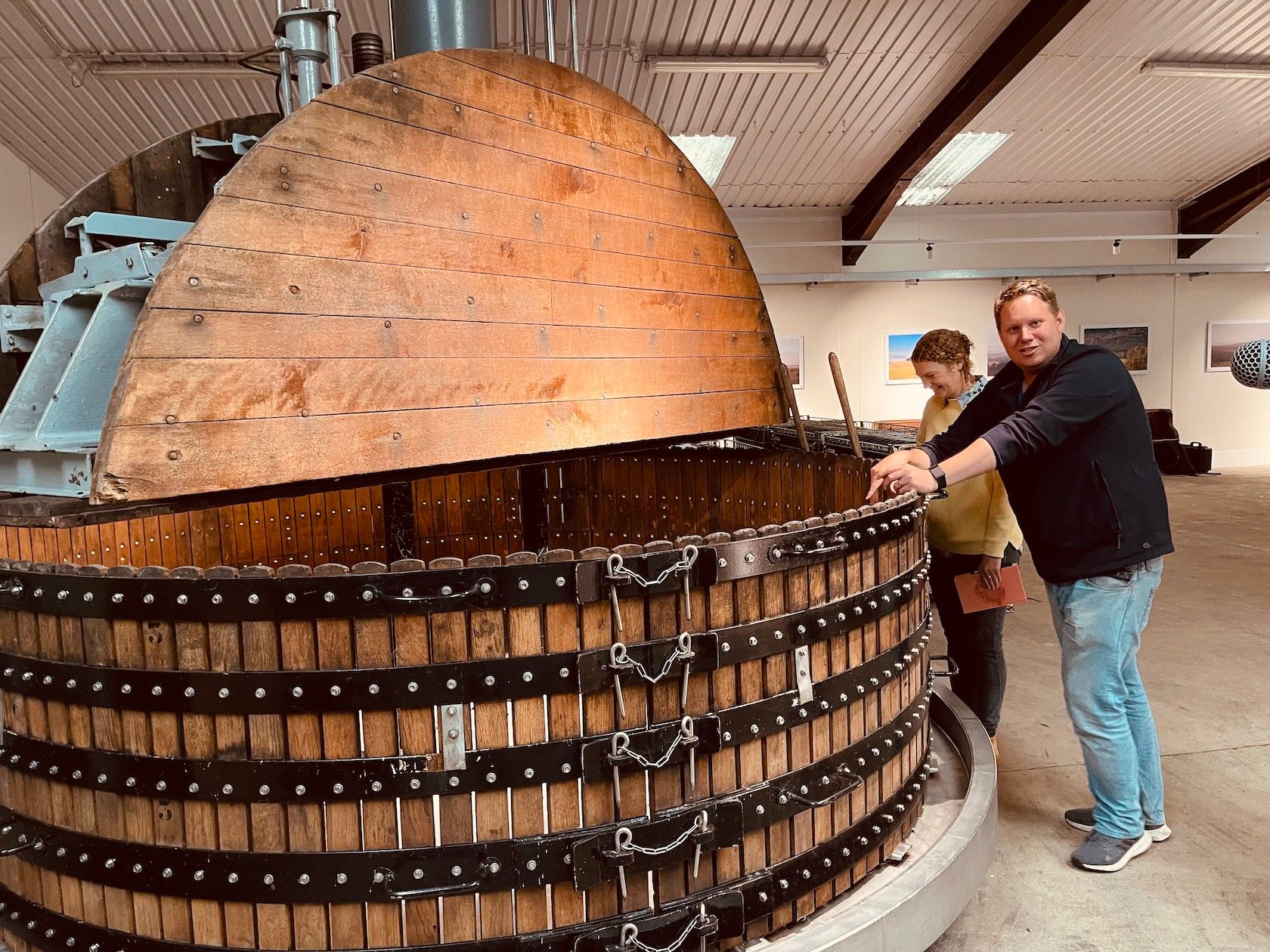“The quality of Wiston wine sends a message in a bottle to the world – a message that shows just what English wine is capable of today and its very real potential for tomorrow,” writes Garnett.
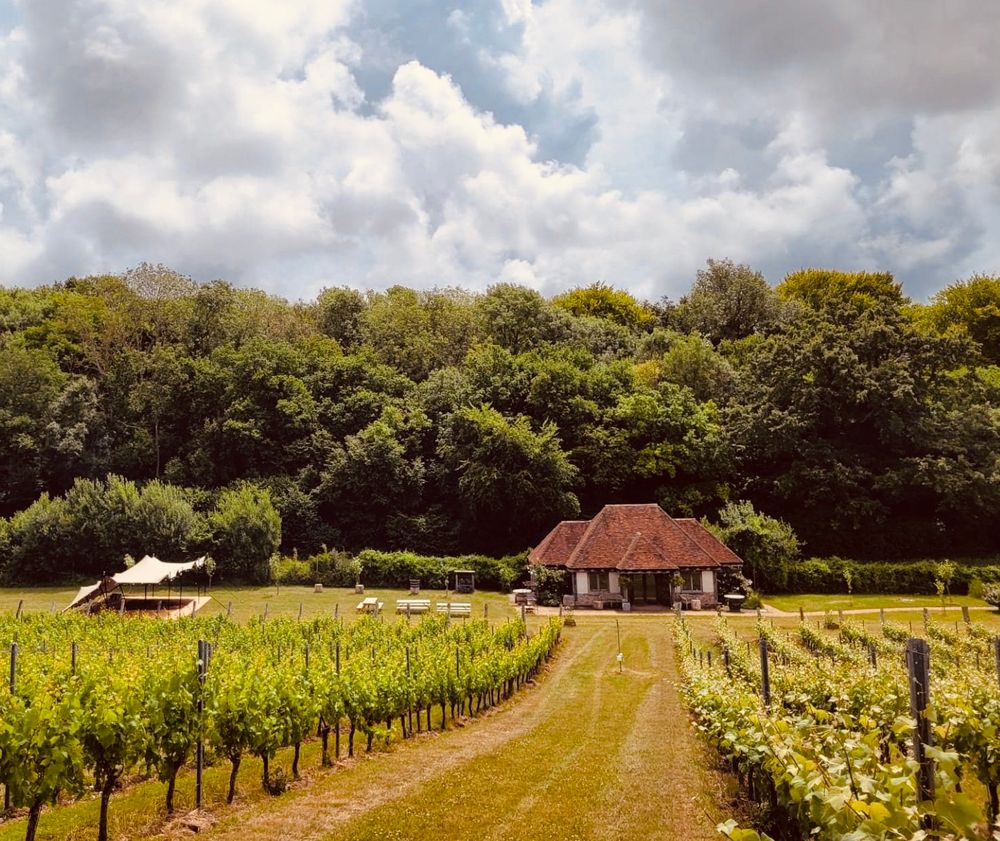
Wiston Estate: the vineyards are just a tiny part of the 6000 acre estate
When I interviewed Cyril Brun, former chef de caves of Champagne Heidsieck now at Ferrari, this week, I asked if he saw the potential for greatness in any other sparkling wine region. Without hesitation, he said Britain and added: “I love the wines of Wiston, I love the team, I love the project. I have known the wines since the beginning, and they are night and day compared to 15 years ago.”
It is a sentiment offered by many in the trade. Admiration is bestowed over more than divine wine. Wiston conveys humility and a genuine desire to build a sustainable business that will see us all out and the generation behind us. To do this, they are prepared to take time, an essential ingredient of any good wine.
It is said that the UK climate today is similar to Champagne’s 50 years ago. Unusually, Wiston Estate is happy to declare its allegiance to France. Tori Eeles, head of sales and marketing, says: “Wiston non-vintage proudly emulates Champagne. We have wonderful acidity; we blend in our reserve wines and age on lees; all of this makes an impact. The non-vintage wines show acidity, character and flavour intensity. The vintage wines are an amplified version of the non-vintage in intensity and complexity.”
Eeles spent many years working in Champagne; she exhibits a quiet and appealing humility.
Production lies between 70 and 80,000 bottles, depending on the year; they’d like to bring it up to 100k. They use their own fruit for the vintage labels but buy in some for non-vintage; they also buy Meunier from Kent as they find it has more depth of flavour off clay than chalk. Marcus Rayner-Ward, their eloquent, capable winemaker, describes it as the ideal ‘bass note’. They have 12 hectares of Chardonnay and Pinot Meunier, and Pinot Noir is grown entirely on chalk, the same chalk you’ll find in Kent and Chablis.

Wiston Estate lies on the same bed of chalk as Chablis
A little bit of Wiston history
On moving to England in 1972, Pip Goring, a Saffer and Wiston’s chatelaine, asked Harry Goring to plant vines to remind her of home. He promised to think about it, and that’s precisely what he did for about 35 years. The opportunity came at last when the sale of an old dairy provided much-needed capital. Wiston’s first vintage was released in 2008. The juice was produced with a secondhand beaten-up Coquard circular basket press, all the way from Champagne, the first to grace English shores. It needed some love, and that’s what they gave it. Today, Daniel Ham of Offbeat and Domaine Hugo have one, too.
Rayner-Ward worked alongside Dermot Sugrue for four years and is a brilliantly capable successor. He has that humour and benchmark humility that is evident all about the place. Newly wed to Meghan (he’s taken her name, and she has taken him), his assistant winemaker, their love can only add to the blend.
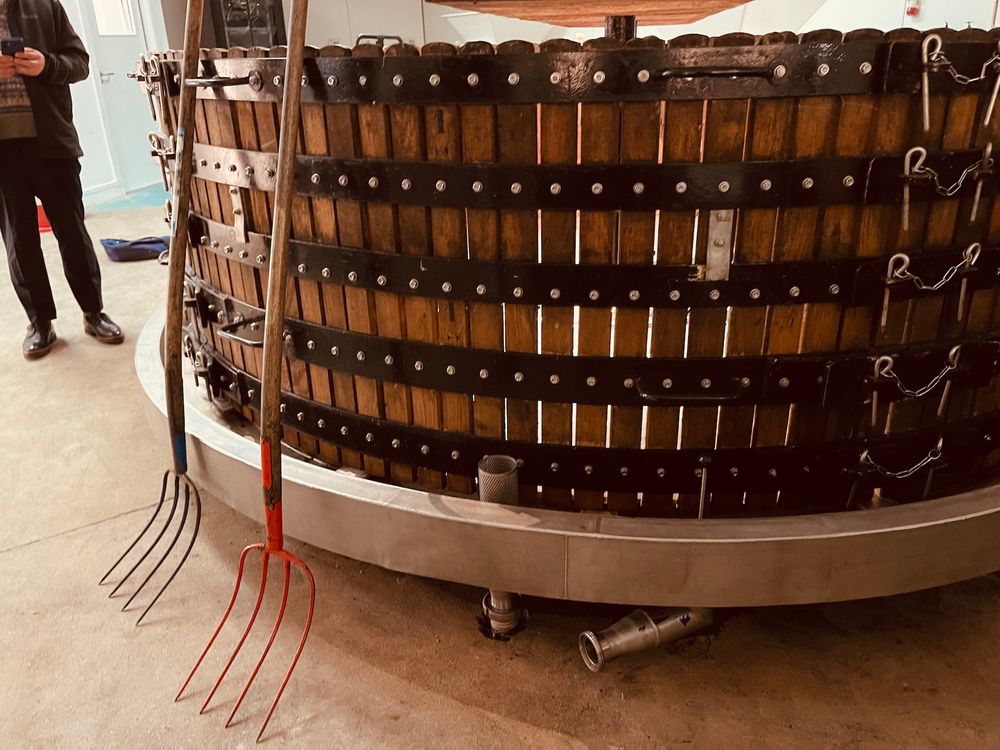
The Coquard press at Wiston Estate – slower and more gentle than a pneumatic press
Eyeing the savage-looking His and Hers pitchforks leaning against the Coquard, I ask Rayner-Ward if this antiquated press is a ball ache to use: “It is trickier than the modern pneumatic presses to deal with, but actually, there is a beauty in that. It’s incredibly physical; you are not just chucking grapes into a tube. You must dig the grapes up yourself to create a platform for the press to start again, and then you must dig the grapes out by hand. There is a physicality. And all the while, the whole emits this profound vibration that you feel in your heart and chest. Pip calls it the African drum.”
The press is also slower and gentler than even a pneumatic press. There is no pumping, and it’s oxidative. Rayner-Ward says it “provides a healthy dose of oxygen at the start, which serves to protect the grapes from oxidation later down the line.”
You can pick it up in the style. The Wiston Reserve and all the vintage wines go through this press and then into the barrel for extended ageing. Here, the wine will partially evaporate and become more concentrated. It will breathe through the wood. Those oxygen molecules will interact with the volatile molecules in the wine. This slightly accelerates the ageing process, creating more interest and texture in the wine.
“When we use oak at Wiston, we don’t use new oak; we are not after those flavours; we are after the texture the barrels provide through oxygenation. Each barrel develops its own personality, and when you bring those characters back together nine months down the line, you have a palate of flavours far more interesting than something that’s been sat in a tank.”
“What we try and do here is not to interfere too much. With our non-vintage, we add reserve wines, but we are celebrating our individual plots, we are not using lots of different yeasts, we are not changing the characteristics. Vintage variation is to be celebrated. We are not after homogenous wine. We are not doing malolactic, we are celebrating the acidity, it acts as a fantastic vessel with which to age the wines further down the track. The signature of Wiston is our ability to age our wines. I think we are only really starting to discover now how far English wines can age.”
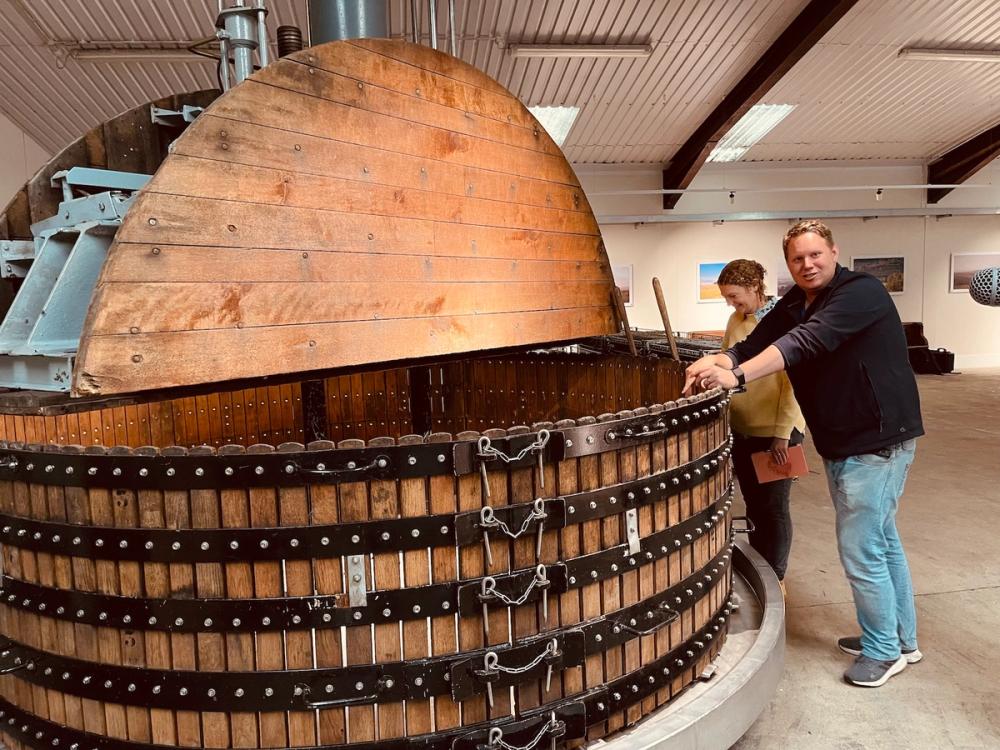
Wiston winemaker Marcus Rayner-Ward and Tori Eales
Tori Eeles adds: “Ageing British wine is something we are championing. We have been doing an audit recently of our library. We always keep a minimum of 20 bottles of anything and we have decent chucks of some of the earlier Wiston vintages, some of which still taste young. There is a 2009 Blanc de Blancs on lees that we are going to release in the next year or two. We are lucky because we have space and buildings in which we can keep the wine.”
As Cyril Brun said: “Time is a key element when you make wine. If you want to rush, you will never succeed. The big boss is nature; one year, you will be fortunate and you will get the best grapes, the next year you might get grapes that are more challenging and then you have to think a little bit out of the box to find solutions to make the best wine. That’s how you improve your knowledge.”
Rayner-Ward has only just taken over the reins from the much admired and fêted Dermot Sugue who was in tenure for 16 years… has he got the stomach for it? Absolutely.
“It takes three years for a vine to pass through one life cycle. In 2022 the fruit quality was amazing especially for our newest Chardonnay vineyard, when we tasted those juices from the Coquard, it was really evident that the purity from this vineyard was perfect for the Vintage Cuvée Brut, but that has always been made with fruit from the single vineyard at Findon. Yet when we tasted that purity…. it was nerve-racking as it was the first vintage since Dermot left and it had always been the fruit from Findon that we used but… when we put that new fruit in barrel and then on blending trials, the quality spoke for itself,” he explains.
Doing the math
Wiston also acts as a contract winery for a number of highly successful brands, something that enriches Rayner-Ward’s’ winemaking experience. “We are fortunate here; we get to experience a lot of wonderful local vineyard expressions, our partners have spent a lot of time, passion and money on their vineyards and we benefit from that.”
So is Wiston Wine beginning to make a profit? “It’s a complicated thing actually to do the maths on,” says Eeles. “The estate is a complex web; ultimately, I would say yes, but it’s very hard to calculate. The vineyard was planted in 2006, then we bought the press two years later. Branding costs also come into the picture. We have had a lot of head-scratching meetings about this; it is difficult to do the maths on what it costs us to make a bottle of wine. It’s an ongoing question. We are certainly surviving, so something must be working.”
Rayner-Ward adds: “We wouldn’t be here today without our contract clients. They are a massive part of Wiston’s winemaking ability, and we are incredibly grateful to our partners.”
“This is a hard-working farm that supports a lot of families; we have to look after nature whilst generating food for lots of people. There is also a vast amount of rare chalk grassland habitat on the estate to protect. All of the meat served at Chalk comes from estate farms. The veg and fruit also come from a beautiful walled garden on the estate,” adds Eeles.
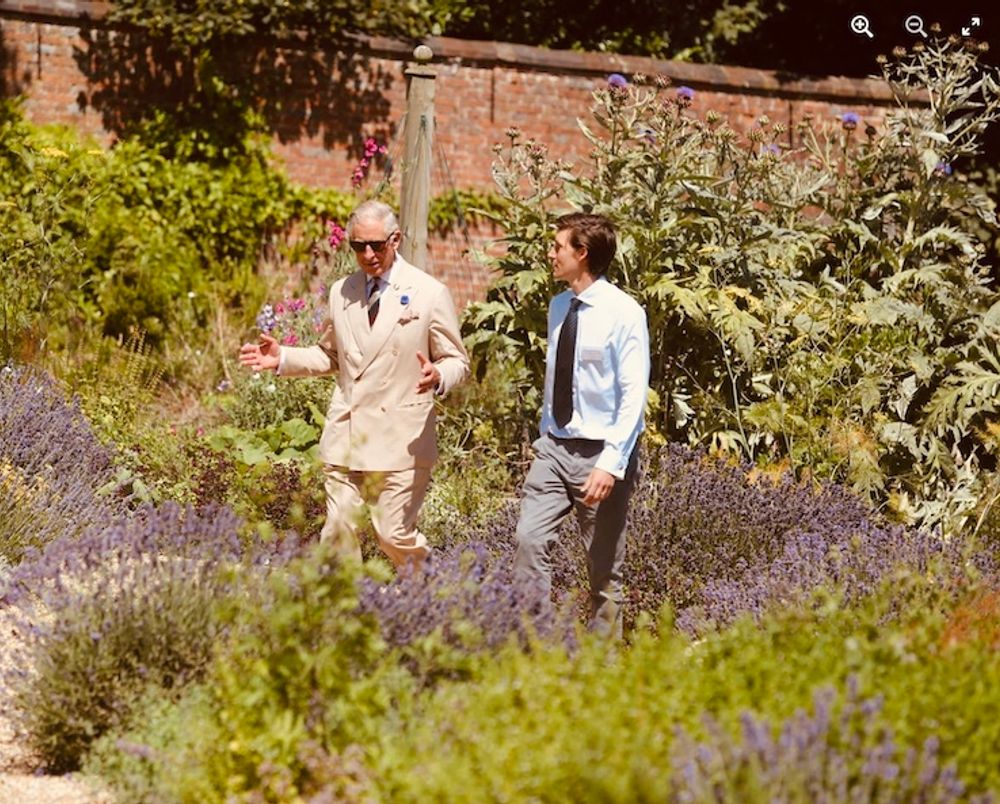
Well connected: His Majesty and Richard Goring at Wiston Estate
The main house is a beautiful Elizabethan manor leased to the Foreign Office since the 50s (the family moved out in the 1920s, having been hammered by double death duties). It is worth reading up on Wilton Park, the organisation housed there. The work they undertake is astonishing: X-Men-level peacekeeping and diplomacy. They bring people together who might otherwise tear one another apart, the beauty of the chalk Downs being their secret weapon. Every year, they hold a nuclear summit. The work they do reverberates throughout the modern world. Their aim is world peace – simple to write and profound to contemplate.
You might say the Goring family are old-school custodians. They are acutely aware of time and the moral obligations of managing a vast tract of England. They are not play farming; their 70-plus workers, tenants and those they feed depend on their able husbandry. The whole estate is 6000 acres and produces many challenges; wine is a tiny part of that. Yet the quality of their wine sends a message in a bottle to the world – a message that shows just what English wine is capable of today and its very real potential for tomorrow.
Tasting the Wiston Estate wines

Wiston Brut Non Vintage 12% ABV, 35% Chardonnay, 35% Pinot Noir, 30% Pinot Meunier. £34
This is their benchmark flagship wine. The base is 2016, with roughly equal proportions of fruit. No barrel ageing but it has 20-40% reserve wine. They use a Champagne version of a solera, essentially a reserve tank which they extract reserve wine from, refreshing it every year. This, they hope will provide a kiss of all the vintages dating back to 2008. Disgorged August 22 (five years on lees). The wine offers an exceptional cornucopia of layered flavours and aromas. The wine is pure, crystalline and complex with a sublime salty note. Bruised red apple, honeysuckle, cinnamon, toasted hazelnuts, lemon sherbet, elderflower, Biscoff and pith compliment delectably fine apple charlotte scented froth. Mouth moistening purity and zip drive the richness through to clarity and freshness and an endless finish.
Wiston Blanc de Blancs Non Vintage 12% ABV, 100% Chardonnay £38
The only English non-vintage Blanc de Blanc, stainless steel with 2019 reserve. Designed by Dermot for sea food. It’s an early release for Wiston, it saw barrels and was aged on lees for three years. Beautifully developed with Granny Smith apples, buttered brioche, apricot, salty flint, crème brulee and red apple, this wine was made for fish and chips.
Wiston Estate Cuvée Brut 2016 12% ABV, Single vineyard, Findon Park Farm, 55% Pinot, 33% Chardonnay, 12% Pinot Meunier. £48
Fermented in small 228 Burgundian barrels then rested then blended with over five years on lees. An exceptional nose and texture, perfectly poised between zip and creaminess. There is a hint of tangerine, candied lemon, oily almond and apple blossom, red apple, rich brioche, toasted hazlenuts and toffee. Sublimely salty and pithy on the lengthy finish. Creamy, honeyed and absolutely delicious.
Wiston Estate Blanc de Blancs 2015 12% ABV, 100% Chardonnay on chalk. £85
Six years on lees, dosage 8 grams per litre (disgorged 2021), half aged in old Burgundy barrels, half in stainless steel to retain the zippy freshness, then a year on cork. They have more of this that they have yet to disgorge for later release. Red apple, salty flint, honeysuckle, tangerine, creamy vanilla and toffee apple. Sensual, seductive, voluptuous and naughty. This will bring racy pleasure to both your table and tongue.
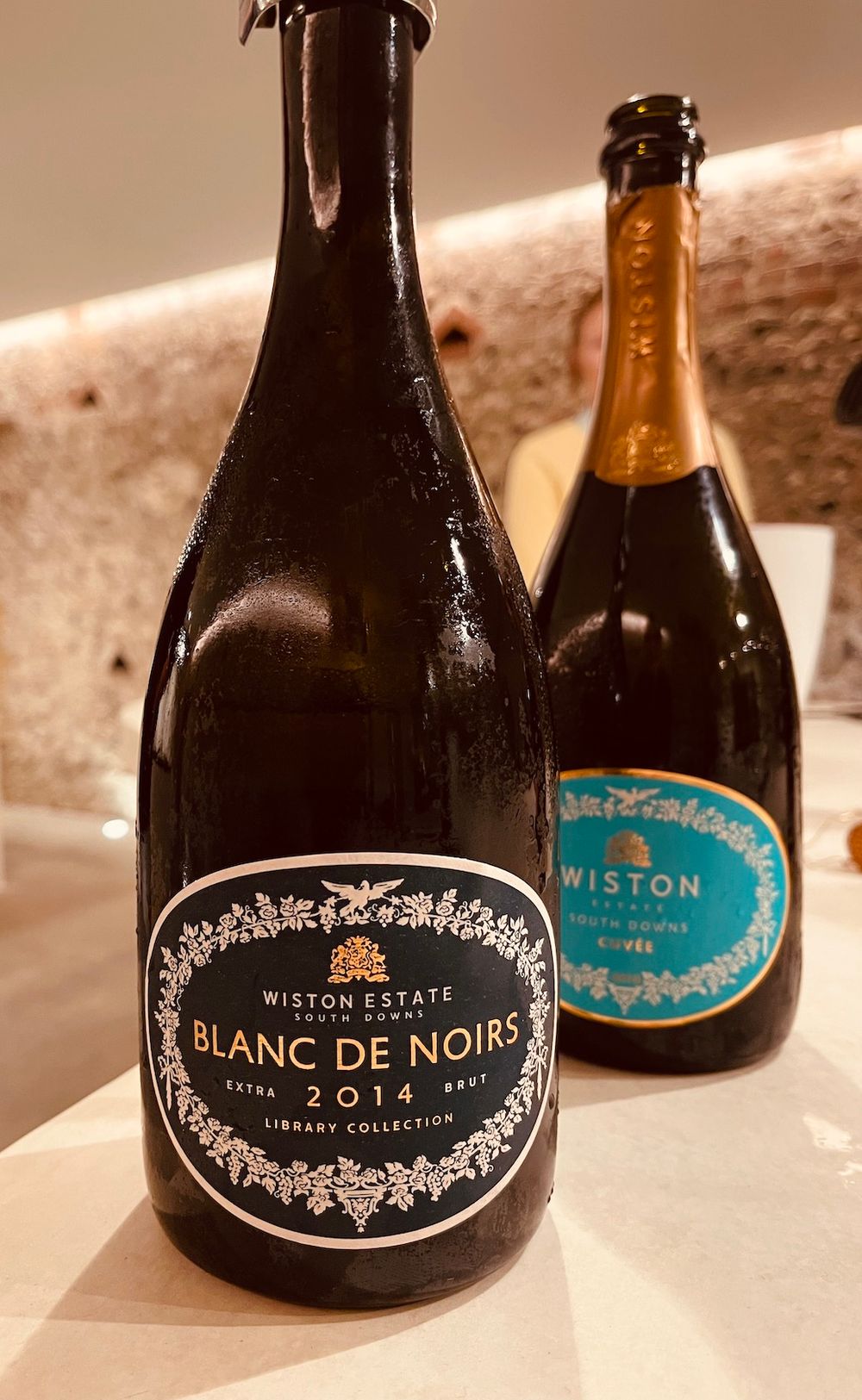
Wiston Estate South Downs Blanc de Noirs Extra Brut, Library Collection 2014 12% ABV, 66% Pinot Noir, 44% Meunier £68
New release. Disgorged 2020, low dosage (3 grams). Co pressed and fermented in fifth and sixth use Burgundy barrels. No malolactic. There is an abundance of gorgeous, quintessentially English fruit and so much natural power in this wine. Razor like and angular with curved smooth edges. There is red apple, oily almond and apricot, buttered brioche, toasted hazlenuts and a gorgeous salty peppered savoury character; a delicately blooming mushroom note, a tender bats squeak of rich rind. This is the gift that will keep on giving for a good many years to come.
- You can find out more about Wiston Estate website here.
